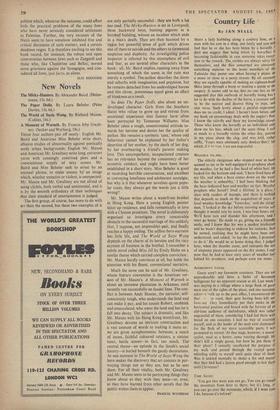New Novels
The World of Suzie Wong. By Richard Mason. (Collins, 16s.) A Moment of Warmth. By Francis Irby Gwalt- ney. (Seeker and Warburg, 18s.) THESE four authors pair off neatly : English Mr. Baird and American Miss Beheler write short, allusive studies of abnormality against poetically seedy urban backgrounds; English Mr. Mason and American Mr. Gwaltney write long, extrovert yarns with cunningly contrived plots and a conscientious supply of sexy scenes. Mr. Baird and Miss Beheler seek to arrest by an unusual phrase, to make uneasy by an image which, whether tentative or violent, is unexpected; Mr. Mason and Mr. Gwaltney are not afraid of using cliches, both verbal and sentimental, and it is by the smooth orthodoxy of their techniques that their standaid of entertainment is judged.
The first group, of course, has more to do with art than the second, but these two examples of it
are only partially successful: they are both a bit too mad. The Micky-Hunters is set in Liverpool; three backward boys, hunting pigeons in •a bombed building, witness an incident which ends in a man's death. They are then haunted by a vague but powerful sense of guilt which drives one of them to suicide and the others to tormented suspicion and duplicity. An investigating police inspector is infected by this atmosphere of evil and fear, as are several other characters in the book : all, Mr. Baird implies, running away from something of which the scene in the ruin was merely a symbol. The, author describes the slums and suburbs with imagination and precision, but he remains detached from his undeveloped heroes and this clever, pretentious novel gives an effect of bleakness as a result.
So does The Paper. Dolls, also about an un- developed character. Girls from the Southern States who refuse to grow up and retreat from emotional experience into fantasy have often been portrayed by Tennessee Williams; Miss Beheler takes a tough, unsentimental attitude to- wards her heroine and denies her the quality of pathos. She remains a synthetic 'case,' whose odd behaviour cannot be explained by her father's desertion of her mother, by the death of her dog, by her overhearing a friend's parents making love. This unsympathetic, incapacitated creature has no relevance beyond the consistency of her eccentric conduct, and might have been better established in a short story. Miss Beheler is good at recording horrible conversation, and excellent at conveying loneliness and adolescent nostalgia; but why is it that whenever novelists quote popu- lar tunes, they always get the words just a little wrong?
Mr. Mason writes about a waterfront brothel in Hong Kong. Here a young English painter takes up residence, andlalls romantically in love With a Chinese prostitute. The novel is elaborately organised to investigate every conceivable obstacle to the successful marriage of this unlikely (but, I suppose, not impossible) pair, and finally reaches a happy ending. The selfless hero-narrator has little life, and The World of Suzie Wong depends on the charm of its heroine and the racy account of business in the brothel. I remember a subtle novel called Miss Jill by Emily Hahn on a similar theme which carried complete conviction: Mr. Mason hardly convinces at all, but holds the attention with his fluent, conventional narrative.
Much the same can be said of Mr. Gwaltney, whose literary convention is the American ver- sion of Mr. Mason's. A Moment of Warmth is about an immense plantation in Arkansas, until recently run successfully on feudal lines. The con- flict is between Andy Hunter, the narrator, self- consciously tough, who understands the land and can make it pay, and his cousin Robert, snobbish and emasculated, who owns the land and has let it fall into decay. The subject is dramatic, and like Mr. Mason with his Hong Kong waterfront, Mr. Gwaltney devotes an intricate construction and a vast amount of words to making it more so : we are given nymphomaniac heiresses, a touch of incest, faithful coloured retainers, a sinister tutor, battle scenes—in fact, too much. The central theme—an episode in the South's social history—is buried beneath the gaudy decorations. At one moment in The World of Suzie Wong the hero makes the discovery that art consists in por- traying things not as they are, but as he sees them. For all their vitality, both Mr. Gwaltney and Mr. Mason seem to be portraying things they know about as they wish they were—or, even, as they have learned from other novels that the public wishes them to appear.
FRANCIS WYNDHAM






























 Previous page
Previous page